Note
Click here to download the full example code
Compares implementations of ReduceSumSquare#
This example compares the numpy for the operator ReduceSumSquare to onnxruntime implementation. If available, tensorflow and pytorch are included as well.
Available optimisation#
The code shows which parallelisation optimisation could be used, AVX or SSE and the number of available processors.
import numpy
import pandas
import matplotlib.pyplot as plt
from onnxruntime import InferenceSession
from skl2onnx.common.data_types import FloatTensorType
from skl2onnx.algebra.onnx_ops import OnnxReduceSumSquare
from cpyquickhelper.numbers import measure_time
from tqdm import tqdm
from mlprodict.testing.experimental_c_impl.experimental_c import code_optimisation
print(code_optimisation())
Out:
AVX-omp=8
ReduceSumSquare implementations#
try:
from tensorflow.math import reduce_sum as tf_reduce_sum
from tensorflow import convert_to_tensor
except ImportError:
tf_reduce_sum = None
try:
from torch import sum as torch_sum, from_numpy
except ImportError:
torch_sum = None
def build_ort_reducesumsquare(axes, op_version=14): # opset=13, 14, ...
node = OnnxReduceSumSquare('x', axes=axes, op_version=op_version,
output_names=['z'])
onx = node.to_onnx(inputs=[('x', FloatTensorType())],
target_opset=op_version)
sess = InferenceSession(onx.SerializeToString())
return lambda x, y: sess.run(None, {'x': x})
def loop_fct(fct, xs, ys):
for x, y in zip(xs, ys):
fct(x, y)
def benchmark_op(axes, repeat=2, number=5, name="ReduceSumSquare", shape_fct=None):
if shape_fct is None:
def shape_fct(dim):
return (3, dim, 1, 128, 64)
ort_fct = build_ort_reducesumsquare(axes)
res = []
for dim in tqdm([8, 16, 32, 64, 100, 128, 200,
256, 400, 512, 1024]):
shape = shape_fct(dim)
n_arrays = 10 if dim < 512 else 4
xs = [numpy.random.rand(*shape).astype(numpy.float32)
for _ in range(n_arrays)]
ys = [numpy.array(axes, dtype=numpy.int64)
for _ in range(n_arrays)]
info = dict(axes=axes, shape=shape)
# numpy
ctx = dict(
xs=xs, ys=ys,
fct=lambda x, y: numpy.sum(x ** 2, *y),
loop_fct=loop_fct)
obs = measure_time(
"loop_fct(fct, xs, ys)",
div_by_number=True, context=ctx, repeat=repeat, number=number)
obs['dim'] = dim
obs['fct'] = 'numpy'
obs.update(info)
res.append(obs)
# onnxruntime
ctx['fct'] = ort_fct
obs = measure_time(
"loop_fct(fct, xs, ys)",
div_by_number=True, context=ctx, repeat=repeat, number=number)
obs['dim'] = dim
obs['fct'] = 'ort'
obs.update(info)
res.append(obs)
if tf_reduce_sum is not None:
# tensorflow
ctx['fct'] = lambda x, y: tf_reduce_sum(x ** 2, y)
ctx['xs'] = [convert_to_tensor(x) for x in xs]
ctx['ys'] = ys
obs = measure_time(
"loop_fct(fct, xs, ys)",
div_by_number=True, context=ctx, repeat=repeat, number=number)
obs['dim'] = dim
obs['fct'] = 'tf'
obs.update(info)
res.append(obs)
if torch_sum is not None:
def torch_sum1(x, y):
return torch_sum(x ** 2, y[0])
def torch_sum2(x, y):
return torch_sum(torch_sum(x ** 2, y[1]), y[0])
# torch
ctx['fct'] = torch_sum1 if len(axes) == 1 else torch_sum2
ctx['xs'] = [from_numpy(x) for x in xs]
ctx['ys'] = ys # [from_numpy(y) for y in ys]
obs = measure_time(
"loop_fct(fct, xs, ys)",
div_by_number=True, context=ctx, repeat=repeat, number=number)
obs['dim'] = dim
obs['fct'] = 'torch'
obs.update(info)
res.append(obs)
# Dataframes
shape_name = str(shape).replace(str(dim), "N")
df = pandas.DataFrame(res)
df.columns = [_.replace('dim', 'N') for _ in df.columns]
piv = df.pivot('N', 'fct', 'average')
rs = piv.copy()
for c in ['ort', 'torch', 'tf', 'tf_copy']:
if c in rs.columns:
rs[c] = rs['numpy'] / rs[c]
rs['numpy'] = 1.
# Graphs.
fig, ax = plt.subplots(1, 2, figsize=(12, 4))
piv.plot(logx=True, logy=True, ax=ax[0],
title="%s benchmark\n%r - %r"
" lower better" % (name, shape_name, axes))
ax[0].legend(prop={"size": 9})
rs.plot(logx=True, logy=True, ax=ax[1],
title="%s Speedup, baseline=numpy\n%r - %r"
" higher better" % (name, shape_name, axes))
ax[1].plot([min(rs.index), max(rs.index)], [0.5, 0.5], 'g--')
ax[1].plot([min(rs.index), max(rs.index)], [2., 2.], 'g--')
ax[1].legend(prop={"size": 9})
return df, rs, ax
dfs = []
Reduction on a particular case KR#
Consecutive axis not reduced and consecutive reduced axis are merged. KRK means kept axis - reduced axis - kept axis,
(8, 24, 48, N), axis=(3, )#
axes = (3, )
df, piv, ax = benchmark_op(axes, shape_fct=lambda dim: (8, 24, 48, dim))
dfs.append(df)
df.pivot("fct", "N", "average")
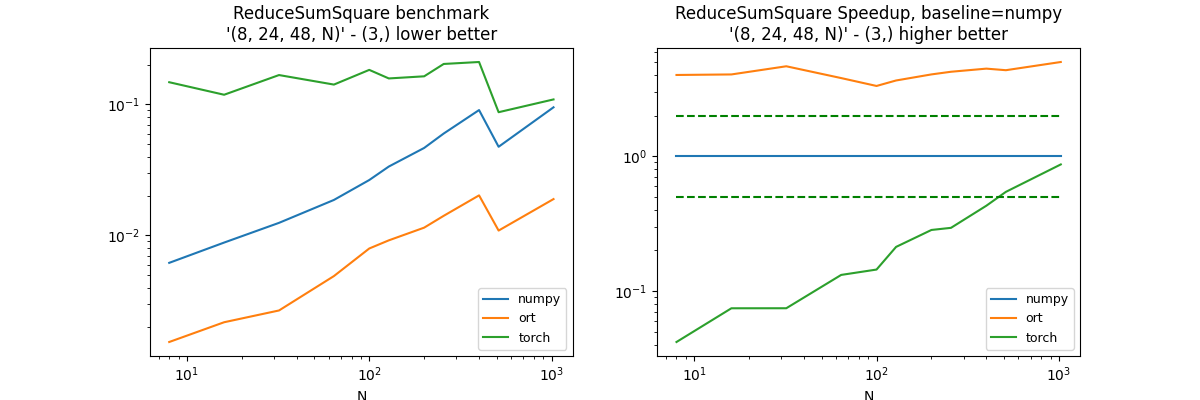
Out:
0%| | 0/11 [00:00<?, ?it/s]
9%|9 | 1/11 [00:01<00:15, 1.58s/it]
18%|#8 | 2/11 [00:02<00:13, 1.45s/it]
27%|##7 | 3/11 [00:04<00:13, 1.67s/it]
36%|###6 | 4/11 [00:06<00:12, 1.74s/it]
45%|####5 | 5/11 [00:09<00:12, 2.01s/it]
55%|#####4 | 6/11 [00:11<00:10, 2.14s/it]
64%|######3 | 7/11 [00:14<00:09, 2.37s/it]
73%|#######2 | 8/11 [00:17<00:08, 2.74s/it]
82%|########1 | 9/11 [00:22<00:06, 3.27s/it]
91%|######### | 10/11 [00:24<00:02, 2.90s/it]
100%|##########| 11/11 [00:27<00:00, 3.07s/it]
100%|##########| 11/11 [00:27<00:00, 2.54s/it]
Reduction on a particular case RK#
Consecutive axis not reduced and consecutive reduced axis are merged. KRK means kept axis - reduced axis - kept axis,
(8, 24, 48, N), axis=(0, )#
axes = (0, )
df, piv, ax = benchmark_op(axes, shape_fct=lambda dim: (8, 24, 48, dim))
dfs.append(df)
df.pivot("fct", "N", "average")
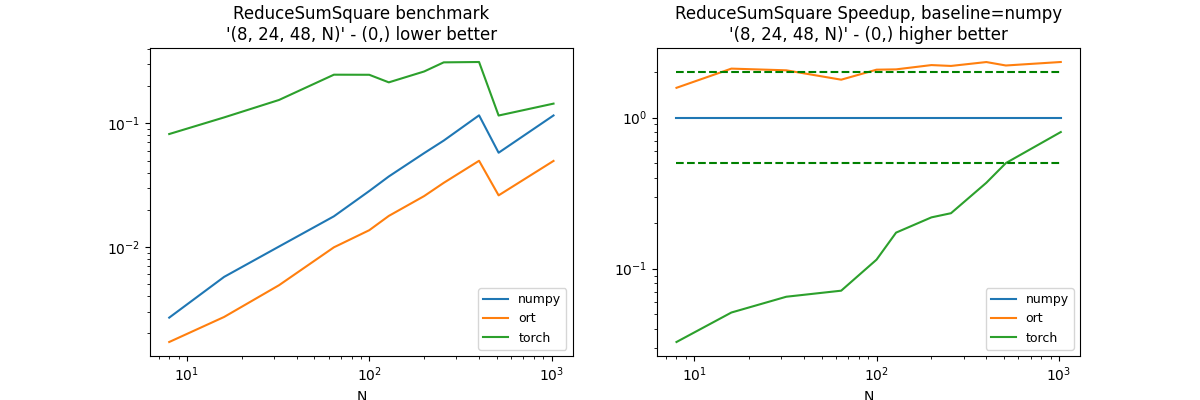
Out:
0%| | 0/11 [00:00<?, ?it/s]
9%|9 | 1/11 [00:00<00:08, 1.12it/s]
18%|#8 | 2/11 [00:02<00:09, 1.11s/it]
27%|##7 | 3/11 [00:03<00:11, 1.42s/it]
36%|###6 | 4/11 [00:06<00:14, 2.03s/it]
45%|####5 | 5/11 [00:10<00:14, 2.45s/it]
55%|#####4 | 6/11 [00:13<00:13, 2.67s/it]
64%|######3 | 7/11 [00:17<00:12, 3.12s/it]
73%|#######2 | 8/11 [00:22<00:11, 3.70s/it]
82%|########1 | 9/11 [00:28<00:08, 4.42s/it]
91%|######### | 10/11 [00:30<00:03, 3.87s/it]
100%|##########| 11/11 [00:35<00:00, 4.01s/it]
100%|##########| 11/11 [00:35<00:00, 3.20s/it]
Reduction on a particular case KRK#
Consecutive axis not reduced and consecutive reduced axis are merged. KRK means kept axis - reduced axis - kept axis,
(8, 24, 48, N), axis=(1, 2)#
axes = (1, 2)
df, piv, ax = benchmark_op(axes, shape_fct=lambda dim: (8, 24, 48, dim))
dfs.append(df)
df.pivot("fct", "N", "average")
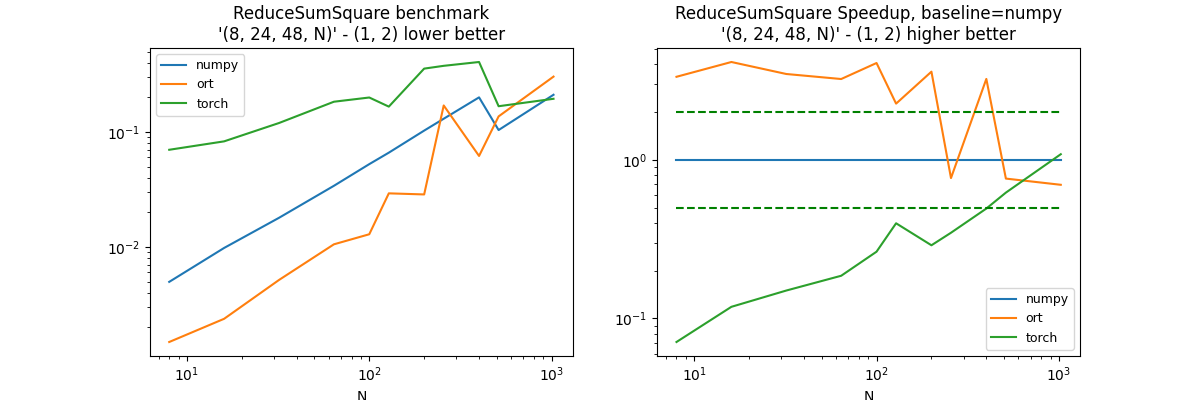
Out:
0%| | 0/11 [00:00<?, ?it/s]
9%|9 | 1/11 [00:00<00:07, 1.26it/s]
18%|#8 | 2/11 [00:01<00:08, 1.08it/s]
27%|##7 | 3/11 [00:03<00:09, 1.20s/it]
36%|###6 | 4/11 [00:05<00:11, 1.70s/it]
45%|####5 | 5/11 [00:08<00:12, 2.15s/it]
55%|#####4 | 6/11 [00:11<00:12, 2.44s/it]
64%|######3 | 7/11 [00:17<00:13, 3.44s/it]
73%|#######2 | 8/11 [00:24<00:14, 4.74s/it]
82%|########1 | 9/11 [00:32<00:11, 5.72s/it]
91%|######### | 10/11 [00:37<00:05, 5.41s/it]
100%|##########| 11/11 [00:45<00:00, 6.30s/it]
100%|##########| 11/11 [00:45<00:00, 4.15s/it]
(8, 24 * 48, N), axis=1#
axes = (1, )
df, piv, ax = benchmark_op(axes, shape_fct=lambda dim: (8, 24 * 48, dim))
dfs.append(df)
df.pivot("fct", "N", "average")
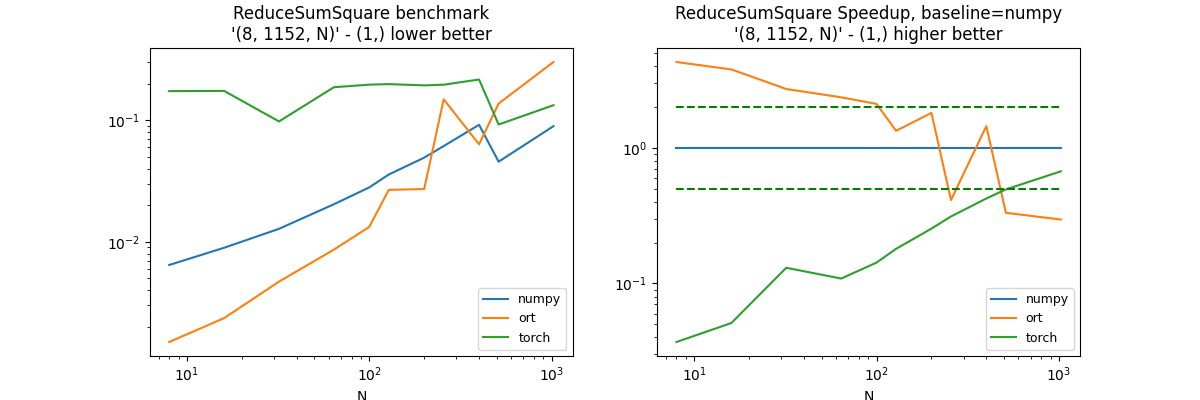
Out:
0%| | 0/11 [00:00<?, ?it/s]
9%|9 | 1/11 [00:01<00:18, 1.85s/it]
18%|#8 | 2/11 [00:03<00:16, 1.89s/it]
27%|##7 | 3/11 [00:05<00:12, 1.60s/it]
36%|###6 | 4/11 [00:07<00:13, 1.90s/it]
45%|####5 | 5/11 [00:10<00:13, 2.19s/it]
55%|#####4 | 6/11 [00:13<00:12, 2.47s/it]
64%|######3 | 7/11 [00:16<00:10, 2.74s/it]
73%|#######2 | 8/11 [00:21<00:10, 3.41s/it]
82%|########1 | 9/11 [00:26<00:07, 3.89s/it]
91%|######### | 10/11 [00:29<00:03, 3.73s/it]
100%|##########| 11/11 [00:36<00:00, 4.58s/it]
100%|##########| 11/11 [00:36<00:00, 3.28s/it]
(2, 8, 12, 24, 2, N), axis=(2, 3)#
axes = (2, 3)
df, piv, ax = benchmark_op(axes, shape_fct=lambda dim: (2, 8, 12, 24, 2, dim))
dfs.append(df)
df.pivot("fct", "N", "average")
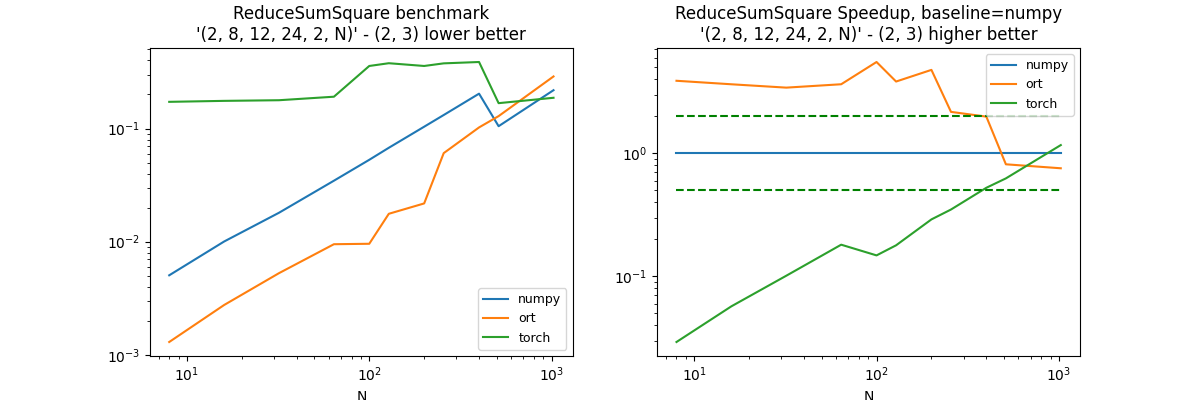
Out:
0%| | 0/11 [00:00<?, ?it/s]
9%|9 | 1/11 [00:01<00:18, 1.81s/it]
18%|#8 | 2/11 [00:03<00:16, 1.89s/it]
27%|##7 | 3/11 [00:05<00:15, 1.99s/it]
36%|###6 | 4/11 [00:08<00:15, 2.21s/it]
45%|####5 | 5/11 [00:12<00:18, 3.04s/it]
55%|#####4 | 6/11 [00:17<00:18, 3.71s/it]
64%|######3 | 7/11 [00:23<00:17, 4.28s/it]
73%|#######2 | 8/11 [00:29<00:14, 4.97s/it]
82%|########1 | 9/11 [00:37<00:11, 5.96s/it]
91%|######### | 10/11 [00:42<00:05, 5.55s/it]
100%|##########| 11/11 [00:50<00:00, 6.36s/it]
100%|##########| 11/11 [00:50<00:00, 4.62s/it]
Reduction on a particular case RKR#
(N, 64, 16, 16), axis=(0, 2, 3)#
axes = (0, 2, 3)
df, piv, ax = benchmark_op(
axes, shape_fct=lambda dim: (dim, 64, 16, 16))
dfs.append(df)
df.pivot("fct", "N", "average")
Traceback (most recent call last):
File "/var/lib/jenkins/workspace/mlprodict/mlprodict_UT_39_std/_doc/examples/plot_op_reducesumsquare.py", line 234, in <module>
df, piv, ax = benchmark_op(
File "/var/lib/jenkins/workspace/mlprodict/mlprodict_UT_39_std/_doc/examples/plot_op_reducesumsquare.py", line 81, in benchmark_op
obs = measure_time(
File "/var/lib/jenkins/workspace/mlprodict/mlprodict_UT_39_std/_venv/lib/python3.9/site-packages/cpyquickhelper/numbers/speed_measure.py", line 86, in measure_time
res = numpy.array(tim.repeat(repeat=repeat, number=number))
File "/usr/local/lib/python3.9/timeit.py", line 205, in repeat
t = self.timeit(number)
File "/usr/local/lib/python3.9/timeit.py", line 177, in timeit
timing = self.inner(it, self.timer)
File "<timeit-src>", line 6, in inner
File "/var/lib/jenkins/workspace/mlprodict/mlprodict_UT_39_std/_doc/examples/plot_op_reducesumsquare.py", line 57, in loop_fct
fct(x, y)
File "/var/lib/jenkins/workspace/mlprodict/mlprodict_UT_39_std/_doc/examples/plot_op_reducesumsquare.py", line 79, in <lambda>
fct=lambda x, y: numpy.sum(x ** 2, *y),
File "<__array_function__ internals>", line 5, in sum
File "/var/lib/jenkins/workspace/mlprodict/mlprodict_UT_39_std/_venv/lib/python3.9/site-packages/numpy/core/fromnumeric.py", line 2259, in sum
return _wrapreduction(a, np.add, 'sum', axis, dtype, out, keepdims=keepdims,
File "/var/lib/jenkins/workspace/mlprodict/mlprodict_UT_39_std/_venv/lib/python3.9/site-packages/numpy/core/fromnumeric.py", line 86, in _wrapreduction
return ufunc.reduce(obj, axis, dtype, out, **passkwargs)
TypeError: output must be an array
Reduction on a particular case RKRK#
(8, 24, 48, N), axis=(0, 2)#
axes = (0, 2)
df, piv, ax = benchmark_op(axes, shape_fct=lambda dim: (8, 24, 48, dim))
dfs.append(df)
df.pivot("fct", "N", "average")
Conclusion#
Some of the configurations should be investigated. l-reducesum-problem1. The reduction on tensorflow in one dimension seems to be lazy.
merged = pandas.concat(dfs)
name = "reducesumsquare"
merged.to_csv("plot_%s.csv" % name, index=False)
merged.to_excel("plot_%s.xlsx" % name, index=False)
plt.savefig("plot_%s.png" % name)
plt.show()
Total running time of the script: ( 3 minutes 27.433 seconds)